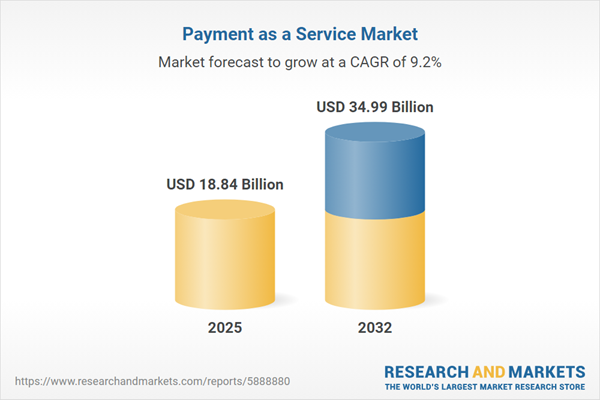Speak directly to the analyst to clarify any post sales queries you may have.
Payment as a Service platforms are accelerating the modernization of enterprise payments, empowering leaders to efficiently manage digital transactions and address evolving compliance challenges. With digital commerce surging and regulations in constant flux, decision-makers increasingly depend on resilient, adaptable payment solutions that balance operational agility with robust security.
Market Snapshot: Payment as a Service Market Trajectory
The global Payment as a Service market continues to advance, driven by heightened demand for secure, streamlined digital payment solutions—particularly to facilitate international and cross-border transactions. Market growth aligns with the increasing prevalence of digital wallets and embedded finance capabilities, as well as broader migration toward cloud-native architectures. Accelerated mobile commerce adoption and a consistent emphasis on seamless user experiences are foundational to expansion in this sector. Market leaders are strengthening platform reliability and integration to address the nuanced, sector-specific requirements of enterprise clients, leveraging robust and adaptable technologies to foster rapid business transformation.
Scope & Segmentation: Payment as a Service Market
- Application Areas: Compliance management, anti-money laundering, fraud prevention, KYC, real-time payments, identity verification, credit scoring, behavioral analysis, transaction monitoring, e-commerce enablement, payment processing, and peer-to-peer payments, supporting elevated risk control and improved user experience.
- Component Types: Consulting services, implementation support, maintenance, and flexible software licensing address complex regulatory and operational needs across enterprises of varying scale.
- Deployment Models: Cloud-native options—including hybrid, private, and public—and on-premise installations cater to differing compliance, scalability, and data residency priorities.
- End User Industries: Banking, financial services, insurance, healthcare, retail, and e-commerce rely on tailored, compliance-driven solutions that meet their sector-specific demands.
- Organization Sizes: Platforms are optimized for both large corporations and small- to medium-sized businesses at any stage of digital transformation, ensuring flexibility for distinct resource requirements.
- Geographical Coverage: Participation spans the Americas, Europe, Middle East and Africa, and Asia-Pacific, supporting adaptation to local regulations and varying consumer expectations.
- Key Providers: PayPal, Stripe, Adyen, Fidelity National Information Services, Global Payments, Block, Fiserv, Shopify, Checkout.com, and Worldline each bring distinctive approaches to client engagement and solution development.
- Key Technologies: Artificial intelligence, machine learning, distributed ledger technology, and advanced APIs underpin secure payment operations, facilitate sophisticated risk management, and bolster process automation throughout the value chain.
- Regulatory Frameworks: Open banking standards, PSD2, data privacy requirements, and evolving payment regulations promote interoperability and regulatory alignment.
- Consumer Behavior: Ongoing adoption of digital wallets, peer-to-peer transaction platforms, and integration of loyalty programs drive continuous solution enhancement and customer-focused innovation.
Key Takeaways for Senior Decision-Makers
- Payment as a Service platforms enable streamlined orchestration of omni-channel payments, supporting geographic expansion and compliance with varied regulatory frameworks and user preferences.
- Flexible integration methods support a smooth shift from legacy systems, reducing operational disruptions as organizations transition to compliant digital payment models.
- Advances in authentication and transaction routing strengthen digital trust and fortify payment network reliability for all business participants.
- API-driven product development and strategic partnerships accelerate innovation, particularly in fraud prevention and detection throughout every stage of the payment lifecycle.
- Regionally adaptable solutions support diverse payment customs and compliance imperatives, enhancing scalability for international expansion and strategic foresight.
- Ongoing platform enhancements address emerging risks and ensure that payment ecosystems remain secure and aligned with shifting regulations and industry standards.
Tariff Impact and Supply Chain Adaptations
- Recent tariff policy shifts in the United States have influenced hardware acquisition expenses, motivating enterprises to reassess supplier relationships and enhance procurement oversight.
- Key providers prioritize local supplier engagement and adaptive pricing strategies to manage risks stemming from evolving global market conditions.
- Organizations strengthen inventory controls and establish contingency plans to maintain operational stability amid geopolitical and economic uncertainty.
Methodology & Data Sources
This analysis draws upon executive interviews, merchant analytics, regulatory assessments, and rigorously validated provider reports. All findings are independently peer-reviewed and corroborated, offering senior leaders a reliable base for informed decision-making around digital payment strategies.
Why This Payment as a Service Report Matters
- Targeted insights highlight technology trends, regulatory shifts, and emerging payment ecosystem dynamics, empowering senior executives to select optimal digital payment platforms for their organizations.
- Actionable strategies align payment operations with compliance mandates, governance criteria, and business performance targets for sustained value creation.
- This comprehensive evaluation links ongoing payment technology evolution to continuous enterprise growth and adaptation to changing customer requirements.
Conclusion
Payment as a Service platforms equip enterprises with the agility to manage digital payments securely, reinforce operational resilience, and continually enhance risk control across a dynamic commerce environment.
Additional Product Information:
- Purchase of this report includes 1 year online access with quarterly updates.
- This report can be updated on request. Please contact our Customer Experience team using the Ask a Question widget on our website.
Table of Contents
3. Executive Summary
4. Market Overview
7. Cumulative Impact of Artificial Intelligence 2025
Companies Mentioned
The companies profiled in this Payment as a Service market report include:- PayPal Holdings, Inc.
- Stripe, Inc.
- Adyen N.V.
- Fidelity National Information Services, Inc.
- Global Payments Inc.
- Block, Inc.
- Fiserv, Inc.
- Shopify Inc.
- Checkout.com Ltd.
- Worldline SA
Table Information
| Report Attribute | Details |
|---|---|
| No. of Pages | 188 |
| Published | October 2025 |
| Forecast Period | 2025 - 2032 |
| Estimated Market Value ( USD | $ 18.84 Billion |
| Forecasted Market Value ( USD | $ 34.99 Billion |
| Compound Annual Growth Rate | 9.2% |
| Regions Covered | Global |
| No. of Companies Mentioned | 11 |









